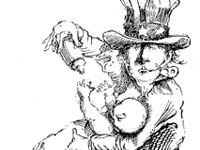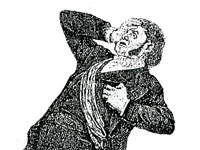Lawn Bowlers Keep Tradition Rolling
Spring 2013

Joggers, cyclists, children, and even dogs passing by can’t help but turn their heads to gaze toward the historic, well-manicured greens of the Frick Park Lawn Bowling Club. The slow-paced “action” that harkens back to a more civilized time elicits an inevitable curiosity from every being.
On the greens, members engage in the sport of lawn bowling—or bowls—that has been played in some fashion since the ancient Egyptians around 3,200 BCE. As the sport spread across the world, it took on a variety of nuances and names, including rolle bolle (Belgian), pétanque (French), and ula maika (Polynesian).
“It’s a lot of fun,” says Randy Ober, a club member and Regent Square resident, who regularly walks to the green along Reynolds Street in Point Breeze with his wife, Anke Bakker, through Frick Park. “It takes about 15 minutes to learn and a long time to get good at it. But if you like games of strategy and tactics, this is it. It’s a game of finesse, so brute force will work against you.”
The game played in the United States is similar to the Italian game of bocce, but with rules that were formalized in Scotland. At the beginning of each game, a white target ball—the jack—is rolled out between the second hog line (69 feet away) and the ditch (112 feet away). As in bocce, the object of the game is to get your ball, actually called a bowl, closer to the jack than your opponent. Players from each team take turns rolling their bowls toward the jack. Once made of wood, bowls are now made of a hard resin and weigh about three pounds.
The Frick Park Lawn Bowling Club near the Frick Art & Historical Center has two adjacent greens. Each green is divided into eight, 15-foot-wide parallel strips, called rinks, meaning eight games may be played at the same time on each green. So that the greens are worn evenly, play is north/south one day and east/west the next.
The game is played as singles, where each player has four bowls; or pairs with two teams of two where each player has four bowls; or triples, the game played most often at the club, with two teams of three players, each with three bowls.

“It’s my first team sport, actually,” says Phyllis Genszler, 65, a Point Breeze resident for 39 years and retiree from PPG. “Jack [Philips] and I have been dating for 25 years, since 1988, and we always used to walk by here. And he said, ‘If I ever move to this area, I want to try lawn bowling.’ Three years ago he moved here, and I said, ‘OK let’s try it.’ It was something we could do together, and we liked it.”
Right: This undated photo of the Frick Park Lawn Bowling Club greens, which were built in 1938, shows how little things have changed since then at the facility—or with the sport in general (above).
The Roman legion is said to have introduced lawn bowling to England, and the game became uniquely British when the bowl took on a shape that is not quite spherical. Weighted more to one side than the other, the bias causes the bowl to curve left or right as momentum is lost. The Southhampton (Old) Bowling Green Club in southern England has the world’s oldest green, where the game of bowls has been played since A.D. 1299. It was so popular in England in the 14th century that King Edward III reportedly outlawed bowls when his soldiers were neglecting their practice of archery.
“The game is a very old, very traditional game,” says club member Dave Wicker, who commutes to Pittsburgh seasonally from Florida for his data storage business and lawn bowls when he’s residing in Aspinwall. “It’s the only sport in the Commonwealth Games you can win while wearing an ascot and smoking a pipe,” he laughs.
It is believed the British built the first bowling green in the U.S. in Williamsburg, Virginia, in 1632. And it wasn’t until about 300 years later, in 1938, that construction commenced for the green and clubhouse in Point Breeze built by the National Youth Administration as part of the Works Progress Administration. By then it was the second public green in Pittsburgh, the first being in Schenley Park, where only a mere vestige of that site remains. Today, the green at Frick Park is the only public green in Pennsylvania, with the next closest being in New Jersey.
“In its heyday in the ’30s and the ’40s, the Frick Park Lawn Bowling Club had around 175 male members and 75 women, though they were not considered members,” explains club president Eileen Luba, a nurse at UPMC Shadyside who won the 2003 national pairs championship with her partner, Lois Saladin of Squirrel Hill. “Later on, in the 1990s, the city came to us and said they could no longer keep the greens and were just going to plow them under. And we said, ‘Oh, please don’t do that, because it would cost us $100,000 to build a new green.’”

Similar to the arrangement between the city and the Pittsburgh Zoo, an agreement was reached to make the club responsible for upkeep of the green although the property remains part of Frick Park. The club’s yearly dues of $175 a person go toward the labor of professional groundskeepers who mow and maintain the greens just as they would a putting green on a golf course. Members then take on some of the easier tasks of applying top dressing, weeding, raking, and maintaining potted flowers.
Left: At a ceremony last summer to dedicate their refurbished clubhouse, Frick Park Lawn Bowling Club members paraded through the park to the greens, led by a bagpiper. Scotland is the home of the modern version of the game.
The 50 or so core members range in age from 23 to 88, almost evenly divided between genders. “One of the things I like about it is that men and women can play equally,” Ober says. “I’ll be the first to admit that my wife is better than me. She has better touch than I do and is much more accurate than I am.”
The Frick Park Lawn Bowling Club oversees a full schedule of intra-club league matches during the summer months on Tuesdays at 10 a.m. and Wednesdays at 7 p.m. On weekends, men and women participate in singles and pairs ladder tournaments.
Neighborhood nights are Thursdays, when anyone interested in trying lawn bowling is encouraged to come at 7 p.m. and receive instruction. Comfortable clothing and flat-soled shoes are the only requirements to get started. Club members are also willing to assist those wishing to host a birthday party or outing at the green.
Members congregate after matches around the clubhouse, which was refurbished in 2011 with funds from the Allegheny Regional Asset District.
“I think the biggest component is the social aspect,” says Luba’s husband, Hank Luba, a retiree from advertising sales, who does the instruction. “But we do belong to the Northeast Division, so you can play very competitively on division levels and in national tournaments. It’s very adjustable to how intense you want to be about it.”
At the start of a game, an observer might see team members shaking hands with their opponents and wishing them, “Good bowls.” As the game progresses, hushed chatter and archaic expressions transport one to a past never forgotten. “You have shot.”…“The jack is alive in the ditch.”…“Throw a runner up the gut.”…“Chop and lie on this bowl.”…“Knock me up.” And “You’re just like my husband—you are short and tight,” which is invariably followed by much laughter.
“Don’t you get good vibrations just from feeling the grass under your feet?” asks Eileen Luba, while moving into position for her next bowl. “And when evening comes, along with the lightning bugs and the nighthawks, this is a beautiful place to be.”
Visit lawnbowlingpittsburgh.org for more information.
With many thanks to SHADY AVE magazine for granting me permission to reprint on my website.


